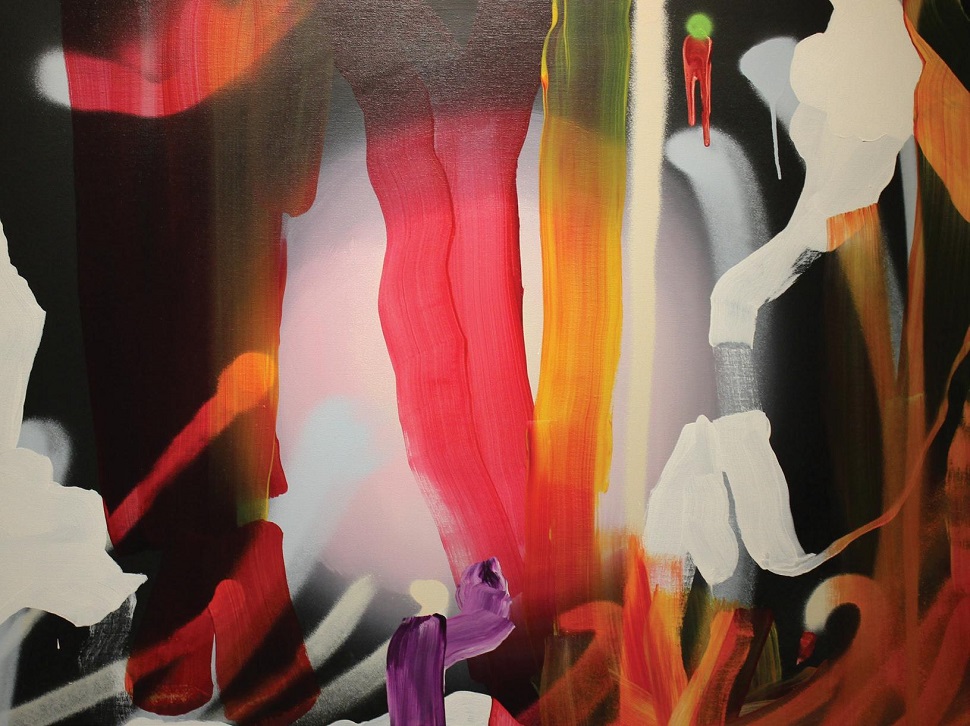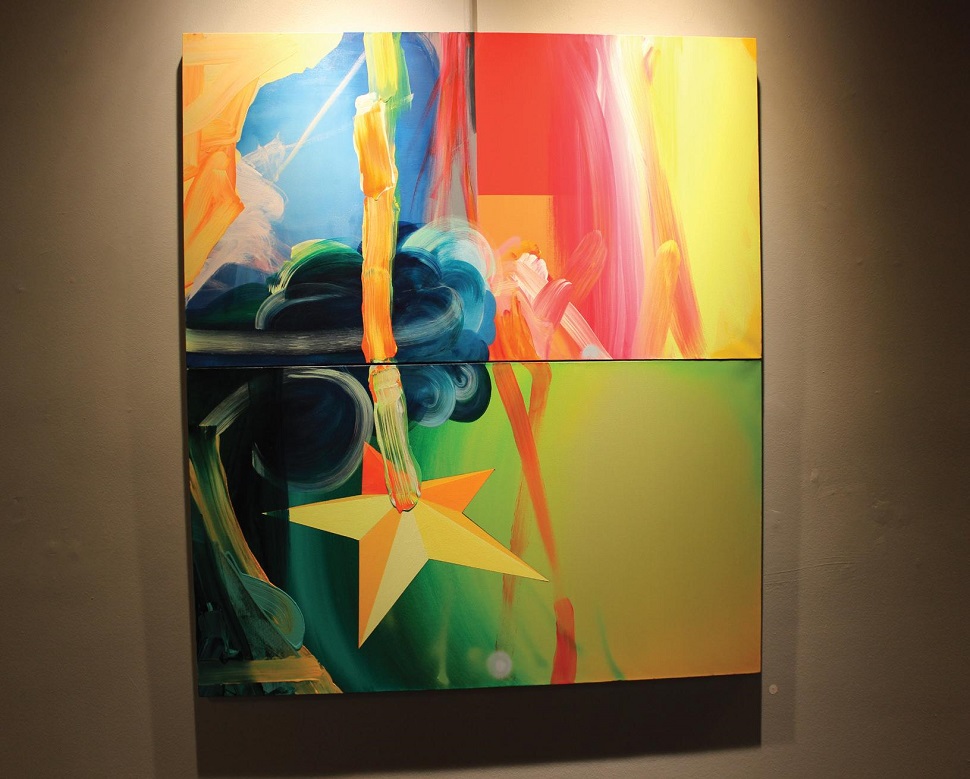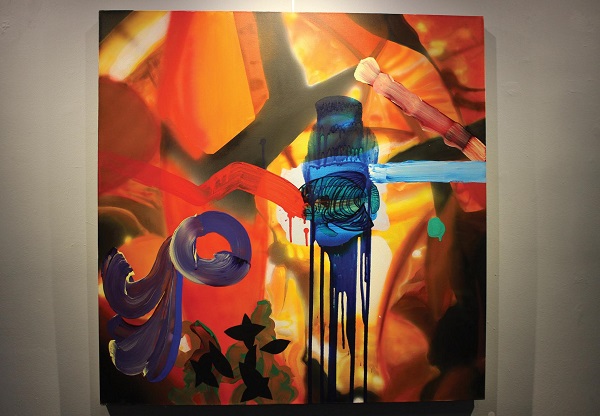
By Ryan McFadden
News Editor
Imagination expressed in paint invigorates East Stroudsburg University with an imaginative diary created by world-renowned artist Kulvinder Kaur Dhew.
Dhew’s “Recent Works” exhibition is a collection of abstract paintings now on display in the Madelon Powers Gallery, located in the Fine and Performing Arts Center at ESU.
The reception for Dhew’s “Recent Works” attracted seventeen people from 3 p.m. to 5 p.m. last Friday and featured a public speaking event from the artist.
Dhew described the paintings as a “diary of the imagination.”
Layers of paint strokes reveal multiple dimensions within one painting and every brush mark exudes emotion.
Through changes in mood, the art gains a narrative tone which describes its purpose of invoking emotional imagination.
The “Phosphorous Interior” painting comes from a chilly dimension.

“Phosphorous Interior” by Kulvinder Kaur Dhew.
Somber shades of pink and yellow first meet the eye but an icy white background soon takes the forefront, engaging the viewer to observe subtle splashes of green, purple and orange that bring the art a deeper emotional range.
From that depth one’s own imagination may delve further.
The result is dream-like, narrative imagery employing vibrant layered colors to form the language in which these paintings speak.
The voice is of an abstract nature and yet, the emotional authenticity is saved by communicating its own depth through changing dimensions of color and shape.
“Sometimes I feel sad, sometimes I feel angry, I try to include all of that emotion to make a more authentic mark. It’s like jazz, more of a free-form thinking. I allow myself to see the canvas as a stage almost like a theatre for a certain kind of narrative to happen,”said Dhew.
“So, it’s not like I’m just going in there and splodging my guts out, there’s a purpose for sure,” said Dhew.
An imagination is created from unique experiences and personality. When the artist creates an emotional narrative with paint, a story is expressed in the art.
The viewer never experiences that same emotion and imagination, instead they receive a platform from which their own minds can imagine and create dreams that blossom into emotional narratives of their own.
“No one can have your imagination. No one can have my imagination, because all of the things that are plugged in to what that is,” said Dhew.
“Where you came from, what your parents did, what they taught you. The people you’ve met in your life, experiences that you’ve had, all of that, it forms us, and so the imagination as an artist I feel very lucky to tap in to and being allowed to.”
Dhew was raised in England a daughter of immigrant parents from India. Growing up in a Sikh cultural context intermingled with British culture gave the young artist a bicultural background, “like an American experience,” she said.
Of major importance in transitioning from adolescence to professional artistry was having the self-determination to pursue a master’s degree in painting from the Royal College of the Arts in London.
Graduate school opened doors to meeting new artists, teachers and cultural icons. It also gave the artist a greater sense of control over what she wanted to do as a professional.
“Generally, the role of education from my experience is that it helped me kind of leap ahead into places in my life I would never have gone had I not gone to college. I would have had an interesting life anyway, but I wouldn’t have been able to travel the world and teach in different countries like I have had I not had my education.”
Dhew taught at universities in the United States, Britain, New Zealand and Borneo. She’s been invited into artist fellowships from the Delfina Trust in London, ARCO in Lisbon to the Vermont Studio Center.
Another way to sustain a career as an artist is to sell the art.
The technological revolution of today’s world has a positive impact on that side of the profession.
Social media and photoshop are simply new tools at the disposal of a creative entrepreneur like Kulvinder Kaur Dhew.
The artist said she will use Photoshop to play around with color relationships and theories before using any paint to visualize paintings. Social Media she described as crucial to establishing a network of art fans and consumers.
“I sold my work to people I haven’t met because of social media, because of Instagram, they’ll get a hold of me we’ll have a discussion and then I might send them a piece that they want,” said Dhew. “I think it’s an incredible business tool.”
Technology brought more sophisticated means of transforming creative visions into reality, but the consequences of dedicating your life to a creative profession have not changed.
“You have to spend a lot of time by yourself just to form your ideas and get it done and so I think when people look at that kind of behavior, its socially not acceptable because we’re social animals and it appears that were not interested in the rest of the world.”
Still, the artistic dream is alive on college campuses. East Stroudsburg University recently unveiled a new Master’s of Arts in communications degree and the university’s College of Arts and Sciences offers 30 different majors.
When asked what advice she would give an aspiring artist cautious of taking risks she described a scenario many Art majors face after completing their undergraduate studies.
“Find a way. Even if it means working in a job you don’t want to do,” said Dhew.
“If the dream of making art is bigger than that job, then go for it one hundred percent. If going to the studio is just a hobby or a habit, that’s something else. For an artist to make a career you do need discipline. It’s hard work just like any profession.”
For Dhew, it all comes back to imagination. The most creative of mental powers is responsible for the artwork, philosophy and story of her life.
Anyone visiting the exhibition in the Madelon Powers Gallery can witness the power of a focused imagination firsthand. As for developing the confidence to become a world-renowned artist, Dhew had this to say.
“I probably come off as quite confident: I’m not,” she said with a laugh. “This is a bit of advice I would give you if you ever have to do public speaking. Think of somebody who you admire the way that they speak, it doesn’t have to be anyone famous, it could be somebody you know, just kind of act like them and then you’ll soon start acting like yourself.”

“Gilded Five-Point” by Kulvinder Kaur Dhew.
Dhew’s Recent Works exhibition are housed in the Madelon Powers Gallery, located in the Fine & Performing Arts Center on ESU’s campus, but it is a sample in a lifetime of paintings.
For more art and information or to contact the artist, go to kulvinderkaurdhew.com, follow her on Instagram @kulvinder_kaur_dhew or friend her on Facebook.
“We all have interesting and important things to say whether it’s through the pen or paint, it’s special,” said Dhew.
Dhew’s “Recent Works” exhibit will be on display until March 8 in the Madelon Powers Gallery.
Email Ryan at:
rmcfadden5@live.esu.edu

